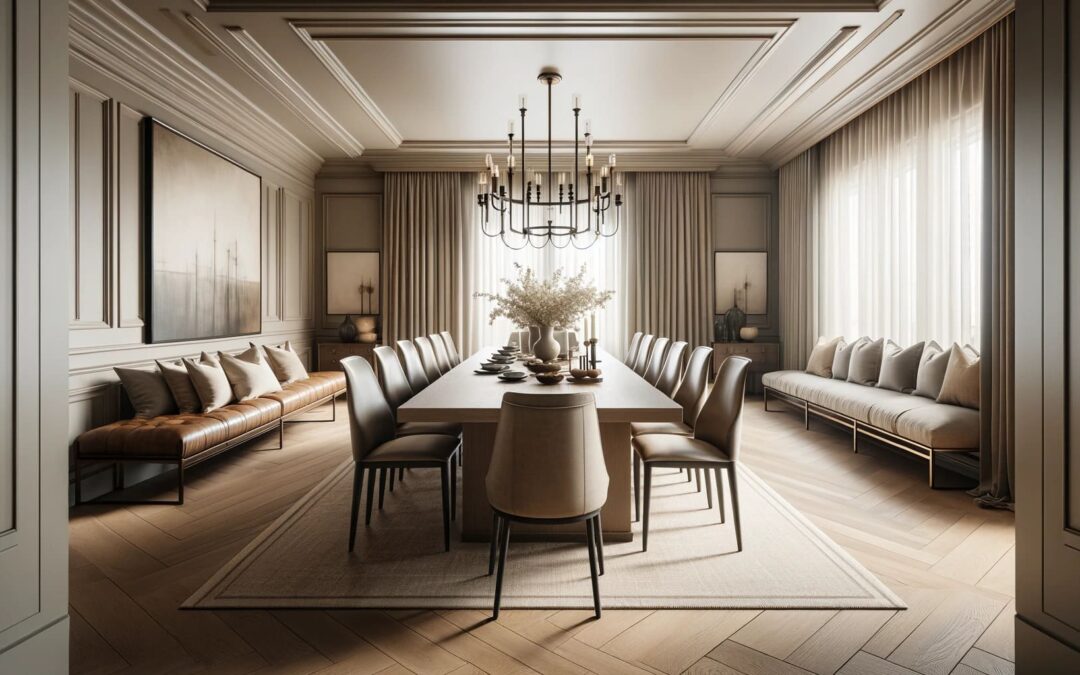In the evolving landscape of home design, the dining room often serves as more than just a space for meals; it’s a gathering place for family and friends, a workspace, and sometimes even a makeshift classroom. The challenge, then, is to create a room that is both functional and stylish—a task where transitional design shines. Transitional dining rooms blend the best of traditional warmth and contemporary sleekness to create a space that is timeless yet modern. Here’s how you can achieve that balance in your own home.
Start with a Neutral Palette
Transitional design thrives on a foundation of neutral colors. Soft beiges, grays, and creamy whites provide a backdrop that is both calming and elegant. These hues not only make the space feel larger and more open but also allow for flexibility in decorating. With a neutral palette, you can easily switch up accent pieces and table settings without having to rethink the entire room’s color scheme.
Choose Streamlined Furniture with Classic Touches
The furniture in a transitional dining room should strike a balance between modern minimalism and classic robustness. Opt for sleek, clean lines typical of contemporary design but look for pieces with subtle detailing that nods to traditional aesthetics. A wooden dining table with a simple silhouette and finely turned legs, paired with streamlined, upholstered dining chairs, can set the perfect stage. This approach ensures the furniture is not only stylish but also timeless.
Incorporate Textural Elements
Texture plays a crucial role in transitional spaces. It adds interest and depth to the room without overwhelming it with patterns or colors. Consider a mix of materials such as leather, linen, wood, and metal. For instance, a leather-upholstered bench on one side of the dining table adds a modern touch, while linen curtains bring softness to the room. A wooden credenza or a metallic light fixture can also serve as focal points that enhance the room’s texture without detracting from the overall aesthetic.
Add Versatile Lighting
Lighting in a transitional dining room should be flexible, and capable of adapting to different moods and functions. A statement chandelier can serve as a beautiful focal point that ties the room together, while dimmable LED lights can adjust the ambiance from bright and functional for working or studying to soft and intimate for dining. Consider adding smaller lamps or wall sconces to provide additional layers of light, crucial for both functionality and style.
Decorate with Purpose
In a transitional dining room, every element should have a purpose. Avoid clutter by choosing decor that enhances both the functionality and the style of the room. Decorative bowls, minimalist art pieces, and elegant vases can serve as beautiful yet practical additions. Ensure that these elements complement the room’s neutral palette and textural variety, enhancing the space without overpowering it.
Embrace Flexibility
Finally, the true essence of a transitional dining room is its ability to adapt to various needs. This might mean choosing furniture that can be easily moved or extended, or incorporating elements like a foldable console that can double as additional dining space. This flexibility makes the dining room not just a place for meals, but a dynamic space that can accommodate everything from homework sessions to formal dinner parties.
By blending the sleek lines of contemporary design with the comforting elements of traditional style, transitional dining rooms achieve a balance that is both inviting and stylish. With thoughtful choices in color, furniture, texture, and lighting, you can create a dining area that celebrates the best of both worlds, ensuring it remains functional, adaptable, and beautifully timeless.

